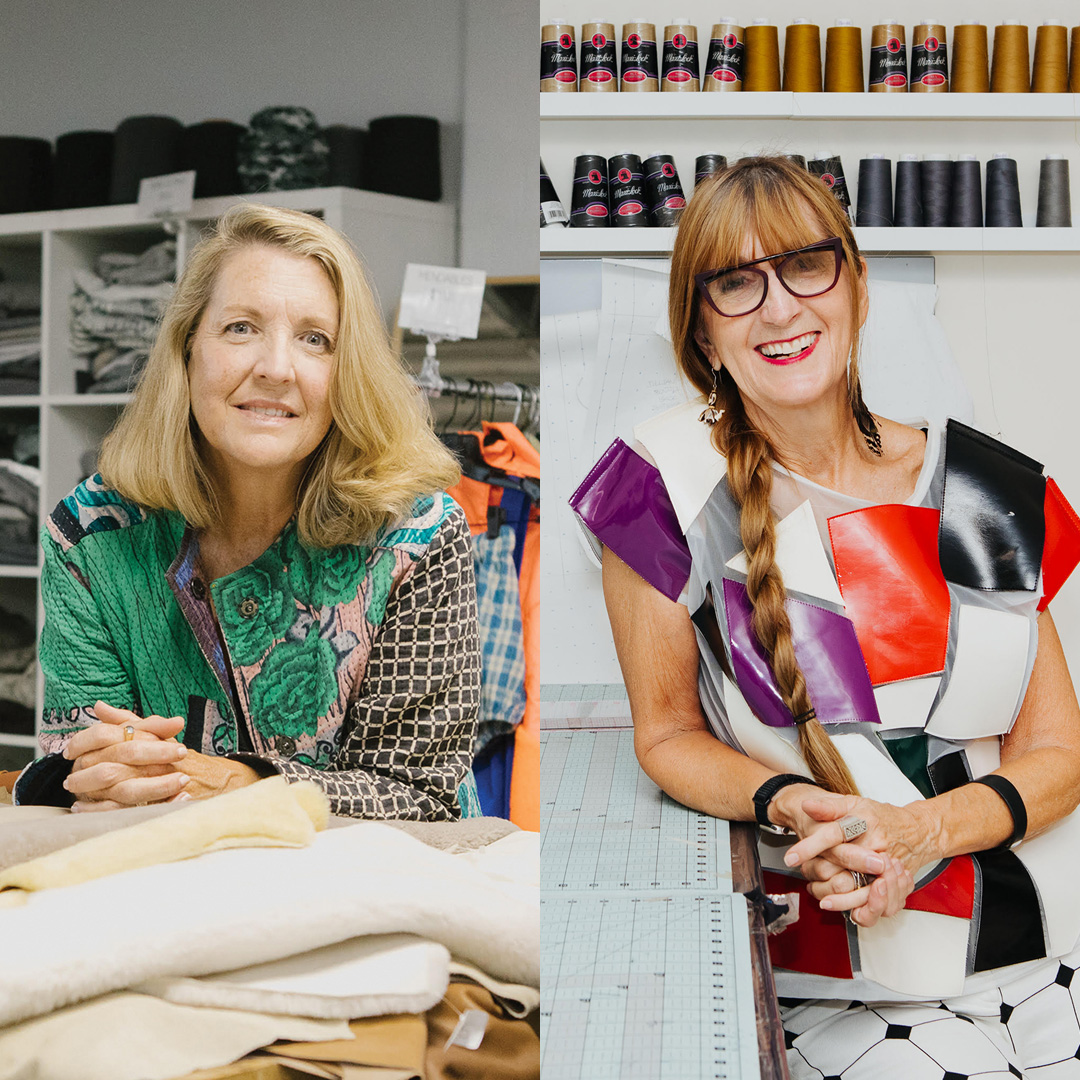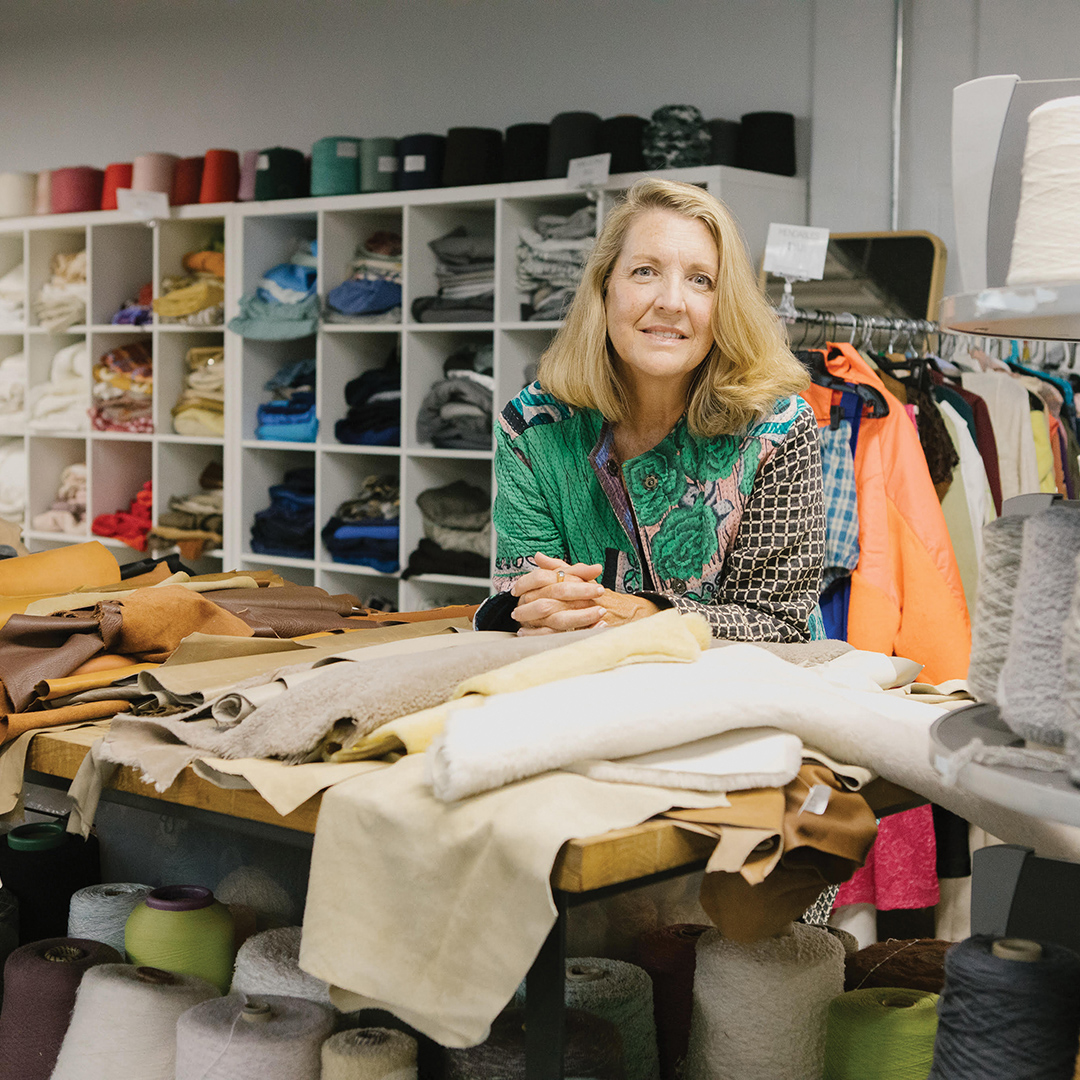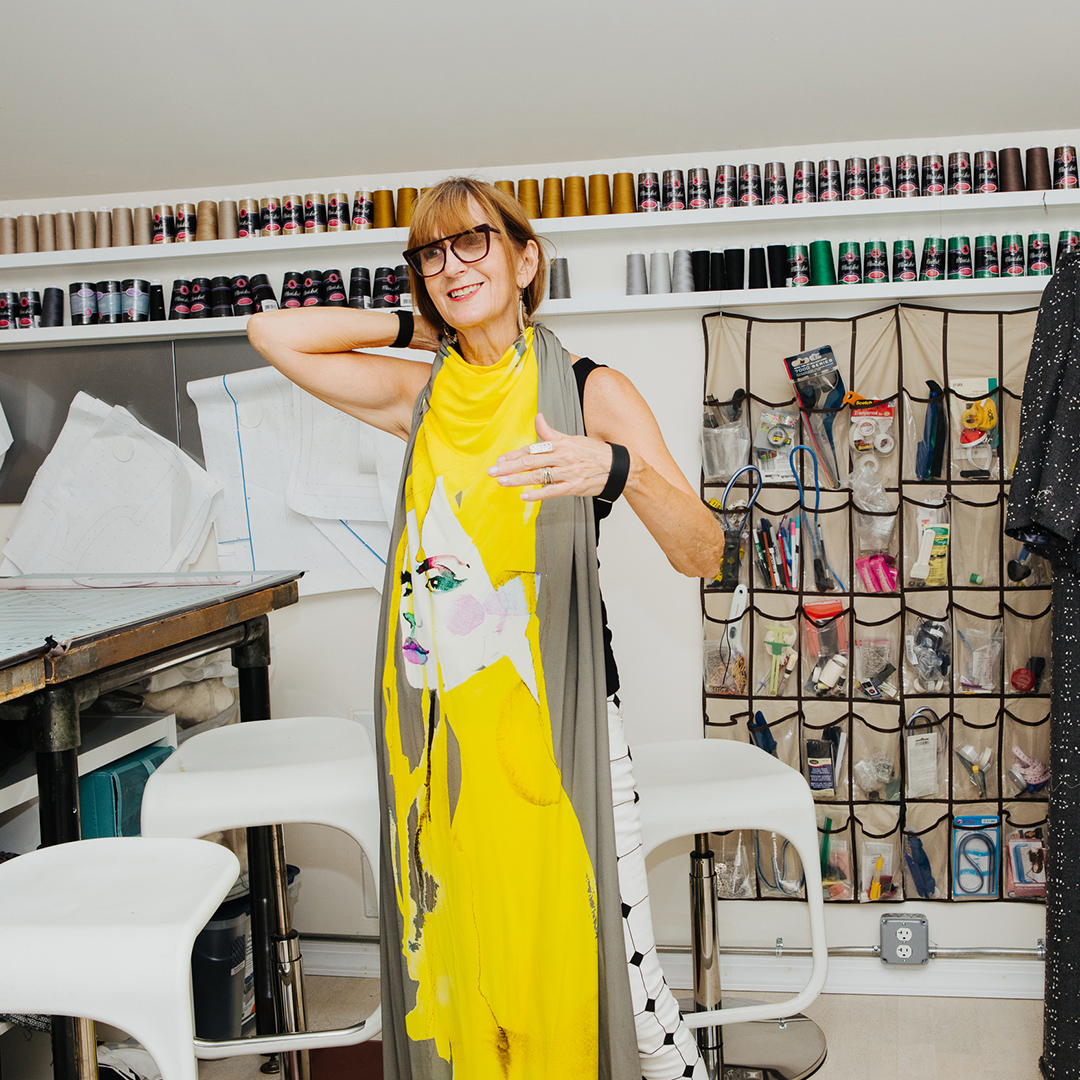Rolling up their sleeves
Professor Kathleen Webber and alumna Nancy Volpe Beringer do their part to put sustainable and inclusive fashions on trend.

Kathleen Webber, left, and Nancy Volpe Beringer, right
Kathleen Webber: Fashion press
In her first-year seminar, The True Cost of Fashion, Kathleen Nicholson Webber chronicles the catastrophic consequences of fast fashion with a round-the-world syllabus spotlighting mountainous landfills of cast-off clothing, waterways tainted with toxins, and brands chasing profits at human expense.

But first, she captures her students’ attention with a critical investigation into their own closets.
Piece by piece, they catalogue, count, and critique the collections. Where did you get it? How long have you had it? What did it cost?
Lists complete, they interview their parents and grandparents about what clothing they owned when they were young. As the answers emerge, the differences become clear. And so begins a semester-long discussion about how and why fast fashion has changed the world.
Since joining TCNJ over a decade ago, Webber, professor of journalism and professional writing, has investigated and written about the thorny problems underpinning the fashion industry, from overproduction and labor exploitation to pollution. But she also spotlights solutions, including legislation to protect workers’ rights, efforts to build sustainable local textile supply chains, and an ambitious new plan to relaunch the flax industry in the United States.
Webber, who has written for Women’s Wear Daily, W, and The Philadelphia Inquirer, is a member of Circular Philadelphia, a nonprofit organization dedicated to reducing waste. She believes in shopping less, and more carefully. “If you ask me, ‘What are you wearing?’ and I bought it secondhand, I will always tell you.”
Here, she tells us much more than just what’s in her closet.
You joined TCNJ in 2012 after a career as a journalist writing about very different aspects of fashion. How did you choose this subject?
I heard this report on NPR about a book called Overdressed: The Shockingly High Cost of Cheap Fashion (see sidebar, page 32). It was about the human costs of moving labor production to countries without much regulation. Right after that — in April of 2013 — there was a factory collapse in Bangladesh that killed 1,134 factory workers. It was fashion’s single most horrific industrial accident. And it happened in a factory where fast fashion was being created. I walked into the office at TCNJ, and I said, “I want to write about this. The sustainability of the industry. The business of fashion.”
Can you talk a little bit about what sustainable fashion means?
Our closets are bursting. When you talk about sustainable production, the question is, can it last? We’re running out of finite resources — water, petroleum — to make things like polyester. When you think about a fabric like rayon, it is made from trees. That is causing deforestation. Sustainability, to me, means that brands will manufacture clothing responsibly. They’re overproducing clothing that ends up in landfills. There is labor exploitation. They are polluting rivers worldwide in the dyeing process. This is not a sustainable business model, and it is not sustainable for the earth.
What’s the history of fast fashion? When did our habits begin to shift toward this kind of clothing?
Fast fashion was supposed to democratize fashion. Clothing brands were taking runway trends, and they were making those trends accessible to everybody at a really low price point. Suddenly, anyone could wear the latest thing. Now, the customer is completely hooked on these really low prices, and they don’t want to give them up. It’s like a fast food addiction. I tell my students to look at their labels, and then we’ll do some research on what the factory conditions are like in that particular country.
What advice do you give people who want to change their shopping habits?
The most responsible things you can do are keep your clothing longer, buy less, and buy secondhand. What about donating clothing? Is that helpful? Most of what you donate doesn’t actually get sold at Goodwill or your thrift store because we are just donating so much stuff every day. And all this stuff is either being burned, or it’s ending up festering in these landfills in places like Ghana and Chile. Our habit ends up being their problem — and so what are the ethics behind that? If you have clothing that you are done using, give it to a friend knowing that they could possibly use it instead of having it sit in the back of Goodwill, never to be sold.
Are you optimistic about our capacity — and will — to solve these problems?
There are a lot of people who really want to clean up the industry. They care about the planet, and they care about people who work in the industry and want to protect them. I feel very positive about that. I’m encouraged that there’s policy work being done to hold brands accountable, but I’m worried because I don’t think we’re solving the problem fast enough.
Do you get the sense that your students are tuned in to the labels and where clothing is made and the sustainability issues that overlap with fashion?
Definitely. I think they just need the tools to figure out how they can shop more responsibly. I feel like I’m always battling the next influencer on TikTok who is trying to sell them something. I don’t teach the class to make them feel guilty about buying from these fast-fashion brands, but maybe to think about buying less. My daughter is 24, and she’s always joked that I’ve ruined shopping for her. When she was a teenager, we’d go to Forever 21, and I would say to her, “If this camisole costs $5.99, what do you think the garment worker was paid?” And she’d be like, “Can you not?”
Your writing really captures the urgency of this issue. Is it hard not to see more progress being made?
I think if I could change my career, right now, I would become a textile scientist. I would try to figure out how to create fabrics that biodegrade, that decompose, with dyes that don’t hurt the environment. But I don’t know how to get people to stop shopping so much. The psychology of it is really something that is just hard to solve.

Nancy Volpe Beringer ’88: Inclusive designer
When Nancy Volpe Beringer’s whirlwind Project Runway adventure ended just shy of the top prize, the designer felt not defeat but exhilaration.
At the age of 64, she’d made history as the oldest contestant to ever compete on the show, and created a go-for-broke final collection that shined a light on sustainable and inclusive designs. With an array of sleek, seamless dresses cut from a single piece of cloth and shimmering gowns adapted for wheelchair users, Volpe Beringer ’88 challenged judges and viewers alike to widen their perspectives — and she was just getting started.
Back home in Philadelphia, Volpe Beringer quickly launched The Vault, the world’s first — and only — luxury resale platform offering free, adaptable options for people living with disabilities. The adjustments she makes to upcycled designer clothing range from replacing the zipper on a Chanel jacket with magnets for a customer with limited dexterity to increasing the height of a waistband on a pair of Prada jeans for someone who uses a wheelchair.
The idea that clothing can be accessible, sustainable, and fashionable is gaining attention within the industry and beyond. Last summer, Volpe Beringer, a past honoree of the Fashion Impact Fund, was invited to speak at the United Nations Fashion and Lifestyle Network annual meeting about her efforts to make fashion more inclusive.
“Project Runway gave me a voice to use for people who are not heard,” she says, adding, “Everyone should have the ability to use fashion to empower and express themselves.”

The path that led Volpe Beringer to this moment began a decade ago when she enrolled in Drexel University’s fashion design graduate program after a career at the New Jersey Education Association. The impulse struck her one sleepless night when she asked herself what she would want to learn if she was young again.
“It was so strange, because the answer was always there,” she says. “Immediately, it was fashion design.”
In a first-semester weekend workshop on adaptive design, Volpe Beringer caught a glimpse of her future. She’d chosen the class simply because it sounded interesting, but the exercises were immersive and the days spiked with challenges: Students collaborated while wearing blindfolds and brainstormed while limiting the use of one hand. Volpe Beringer was energized, thinking about function and fashion in a way she never had.
“It really opened up a world to me,” she says.
At school, she was often asked what she wanted to do after graduation. “I said I wanted to be a relevant designer,” she says. “I didn’t know exactly what the answer meant. But I wondered, ‘Why am I getting to fulfill my dream fantasy at my age?’ I knew there must be a reason.”
The meaning became clear during a midseason Project Runway challenge when she designed a gown and matching train for Tatyana McFadden, the fastest female wheelchair racer in the world and most decorated Paralympian, who lives with spina bifida.
“It was like the universe put me there to design for Tatyana,” Volpe Beringer says.
These days, Volpe Beringer hopes her work with The Vault will inspire similar efforts among designers to make sustainable and adaptive fashion a priority.
“To be honest, I don’t want to be the future of fashion,” she says. “I want to be the designer for now.”

Posted on September 13, 2024

